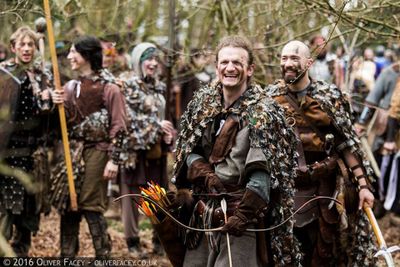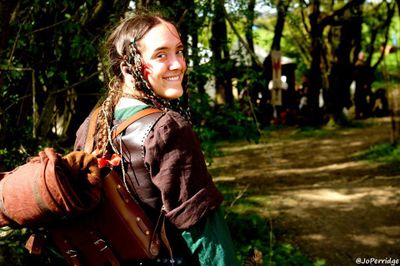Navarr culture and customs
The Great Dance
The central philosophy of the Navarr is the idea that life is a Great Dance in which all humankind is engaged. Some may lead and some may follow, but the Dance is better for everyone when the dancers have the right partners at the right time and place. Many Navarr try to help people find their place and their partners in the Great Dance. People who do not feel ‘right’ where they are should be encouraged to travel to find a new place in the Great Dance, a chance to find a place they will belong, where their partners will be right for them.
Reincarnation is central to this belief - to the Navarr the dead are simply resting for a while before they resume their place. People who find their perfect partner in the Dance are destined to find that partner again and again each time they are born. A partner may not always be a lover, it could be a sibling or simply a close friend.
Tattoos and Vows
The Navarr mark vows, oaths and promises with a physical sign of their intent and commitment, often through tattooing or scarification. The more enduring the commitment, the more permanent the marks. The Navarr mark the most significant vows with brands. These marks help hold a person to their pledge, but they also make it easier for others to identify those who have sworn themselves to a given role or cause (as discussed in Hearth Magic). Most important tattoos are done with a dark red ink, symbolic of the blood that flows beneath the skin. Thorn motifs are the most common design, but other common motifs include blood, twisting plants, star-shaped flowers, and feathers.
Many Navarr who choose to follow a specific calling, such as a thorn or a brand, take on a new mark to signify their commitment. Tattoos that mark an oath of service are generally worn openly on the hand, arm, or face. The mark commemorating a brand's oath - often a literal brand rather than a tattoo- is worn on the left cheekbone, while thorns sometimes eschew a publicly visible mark and instead don facepaint every day to announce their calling.
Skilled tattoo artists are very much in demand in Navarr society, as it is rare that someone will mark an oath or vow with a tattoo or brand that they create themselves. The artist always expects the patron to explain their oath, and will often want to be present personally when they swear that oath. Some tattooists are also priests and may accompany an oath with a testimony that marks the soul as the tattoo marks the body. This combination of skills might also be used by a tattooist-priest when creating a normal testimony - believing that the act of combining a spiritual mark and a physical mark not only makes the testimony "visible" to others but enhances its potency.
While oaths are marked with permanent tattoos or brands, more ephemeral methods of decorating the body are also used by the Navarr. Before engaging an enemy or going into a risky environment many Navarr will paint symbols on their bodies intended to last for the length of the battle or challenge, while henna tattoos are used for commitments expected to last for a few weeks.
The Binding of Thorns
Everyone who joins the Navarr swears the oath their predecessors swore centuries earlier when their cities were destroyed by the vallorn. Once the oath is taken, the new Navarr mingle their blood with all other Navarr who have attended the ceremony, and receive the traditional Navarr tattoo, called the Binding of Thorns - an intricate pattern of intertwined briars or thorns. The Binding does more than just denote an individual as a member of the Navarr. It stamps the oath they have sworn in their flesh, binding them to their commitment for as long as they live. An individual may leave the Navarr, but they cannot put aside the fight against the vallorn without breaking their oath.
All Navarr who have undergone the Binding of Thorns bear this tattoo, one of endless variations on the motif of intertwined briars or thorns. This ceremony is also used when an adult from outside the Navarr wishes to become one of them. The Binding reminds the new Navarr that wherever they go they are part of the Navarr, and that regaining the remnants of their former civilisation from the vallorn is their ancient purpose.
The Vallorn
The appearance of the vallorn started the downfall of the Terunael Empire, and caused the destruction of the great cities that the Navarr once called home. In their place was a fecund abomination, a dense ever growing forest that had cracked and crumbled stone, and shot great trees up through streets and buildings. Here there were monstrous plants and warped beasts that attacked anything that disturbed them. Everywhere the trees grew, the air was so infused with the magic of the Spring realm such that made the plants resistant to all efforts to destroy them.
In response, the Navarr created the trod netowrk, a system of paths and roads that draws on the Spring magic at the heart of a vallorn, like tapping the sap of a tree. Now the structure of Navarr society reflects their generations long struggle to defeat the vallorn, with stridings and steadings each performing a vital role in the war against the horrors of the Spring realm. Magic is a vital component of that battle, with Navarr vates using Spring rituals to extend the trod network anywhere they can reach. But the Navarr treat Spring magic with respect, knowing that it is a weapon that can turn on you at any moment, if you lose control.
As a result there was a longstanding concern about briars who were often shunned as an outward manifestation of the overabundant growth of the vallorn and as a reminder of what was lost. The discovery that briars make particularly dangerous husks when exposed to vallorn miasma only increased the distrust. This discrimination continued until Autumn 383YE, when it was directly challenged in two statements of principle passed the Imperial Synod, by Josephine of Adina's Charge and Friar Jack Reed. Since that time, Navarr citizens have challenged any who would distrust Briars, or assume they have some sympathy for the vallorn based on lineage alone.
Celebrations
The Navarr have a long tradition of marking important moments in their lives with celebrations. Usually these take the form of a shared meal followed by dancing, drinking and gaming. Marking important times strengthens the links between members of a community - especially an extended community such as the Navarr possess. Three important celebrations observed by the majority of the Navarr are Unburdening, The Binding of Thorns and Welcoming.
Unburdening
Navarr Stridings and Steadings are not fixed – they shift and change over time, as people die, retire or move from one to another, perhaps due to a love-match or to a desire to see other climes. When an individual decides to leave a Steading to join a Striding (or even just to travel to another Steading), the event is celebrated with a simple feast in which they ceremonially burn a list describing the belongings they are leaving behind. This symbolises an intent to give up ownership, and comes with a general assumption that these possessions can be claimed by or redistributed among the Navarr who remain behind. The Navarr are far too pragmatic to burn valuable goods, but the ceremony helps people to let go of the things they do not need.
Welcoming
Conscious of the passage of the seasons, the Navarr Stridings congregate at festival times, either together or at the Steadings. The Navarr celebrate the turning of all the seasons but the birth of a new spring and the end of the harsh winter that makes travelling difficult is their major festival. This grand celebration is a time for revelry, feasting, raucous music and wild dancing. It is also traditionally a time for making a new start, abandoning grudges and putting aside past failures to concentrate on the possibilities of a new year.
Welcoming begins with a ceremonial hunt. The traditional quarry of the Welcoming are the Vates, who often adopt fanciful costumes or headdresses that represent game animals, such as stags, hares and pigeons. Details of the hunt vary from year to year; a glorified game of hide-and-seek one year may be followed by a mock hunt through light woodland the next, or a chase across open ground. The hunt is good natured, but some Vates relish the opportunity to employ their magic to make the hunt more exciting.
Come, come, why the tears my sweet? Death is just another step in the Great Dance. We all take it.
Nana Bronwyn WordlessFunerals
In death, what remains are the memories of your deeds in the minds of your partners in the Great Dance. The Steadings use a traditional corpse-glade where the bodies are laid out in the forest. Such glades are rarely troubled by scavengers or carrion-eaters, and the bodies are simply left undisturbed to moulder.
The Stridings usually commit bodies to a simple cairn but a Striding may decide to transport a corpse to a Steading before performing a funeral. There is also a custom where the friends of the deceased make a pilgrimage to a corpse-glade to hang a reminder or memento of their fallen comrade among the branches.
Icons and Artistry
The iconic symbol for the Navarr is the White Tree, a stylised, leafless oak with branches and roots representing the different paths leading to, and extending from, the present moment. It is often depicted surrounded by crimson thorns, representing the sacrifices needed to walk a path. The organic curves and shapes featured in the banner that hangs in the Imperial Senate are common in Navarr paintings, sculptures, and decorations, as well as in the designs for their architecture, landscaping, and body art. Many Navarr decorate their clothing and belongings with images of vines and thorns.
The Navarr prize living art that emphasises the idea of things being maintained or built upon with every passing year or passing striding. A painting on a rocky outcrop might need retouching each time a striding passes by, or they may add a new detail to a tree stump carved to mark the location of a trod. In Navarr eyes, the best art must be constantly maintained so that it can be developed with each iteration or each hand that contributes. Music and performance can be continuously updated with new lyrics and lines to adapt to changing circumstances. Even a piece of furniture can have new carvings added to the wood. The aim is not to improve a piece, so much as to keep it "alive" as a piece of art by constantly working on it.
Seren, in Miaren, is considered the centre of Navarr art. The flowering glades and immaculate gardens are testimony to what humanity can achieve when the natural world is tamed. To the Navarr tending nature to make it both benign and beautiful is a crucial artform - one that can be practised by everyone whatever their level of skill. Every part of the surrounding forests that can be improved on is available, glades can be opened up to allow flowers to grow on the floor below, seeds planted to create tree-lined paths and lanterns strung from branches to make the forest a riot of colours at night.
Further Reading
Core Brief
Additional Information


